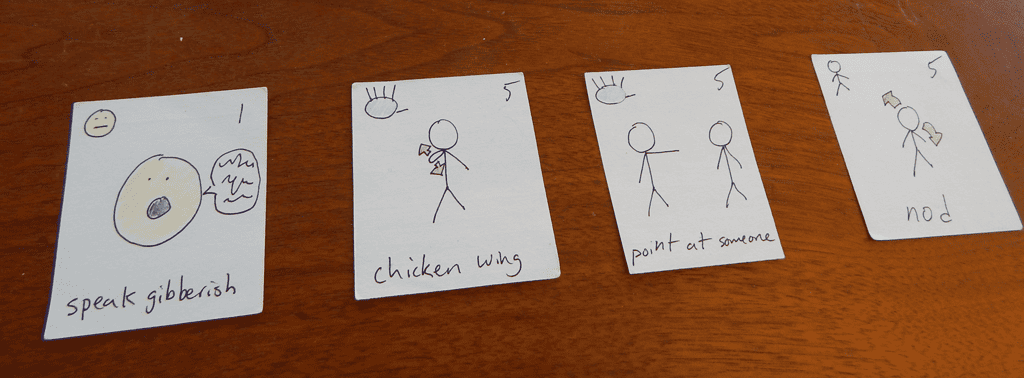
Sometimes, games emerge from a designer’s mind fully formed and wonderful. Maybe they have some tiny issues here or there, but small tweaks will fix those problems. The initial vision survives the playtest guantlet, coming out the other side largely unchanged.
Most games, in my experience, aren’t so perfect when first conceived. Often times, games start as small fragments and build up. Maybe the designer has an idea for a novel theme, but isn’t quite sure how to mechanically implement it. Or maybe she liked a mechanic she was toying with for another game that didn’t make the cut, and now she wants to build a whole game around it to really show it off. However it happens, many games I design, and I would wager many you have and will design, start from humble, scrappy beginnings and require a lot of experimentation and support to be ready for prime time.
One of the main reasons I wrote my Game Elements series for the League of Game Makers is because I find myself in this situation often. I’ll have a rough, basic idea for a part of a game, but I’m not sure what else the game really needs. By identifying what most games need or benefit from, I hoped to make it easier to build around the parts you already feel comfortable with, and make it easier to identify when certain parts just aren’t working.
I recently went through this experience, so today I thought I’d share a bit of the story. Let me tell you all about Strange Rituals.
SOPHMORE ACTS
Way back in early 2013, I’d finally finished the files for Corporate America, my first big game. It’s a long and difficult process to self publish, and it was my focus for almost a year. But with the files submitted to the printer, I suddenly had a lot more free time. So I did what any self respecting designer would do: I started designing new games.
Strange Rituals was born one night when my car broke down in a sleepy corner of California and I found myself unexpectedly staying in a grungy motel in a ho-dunk little town. With little to distract me, I sat down and hammered out some cards for a weird idea I had: a game where players act out multiple simple gestures to create complex “rituals”. The gestures are divided into face gestures (stick out your tongue, look extremely happy, speak gibberish, etc), body gestures (jump up and down, stand on one foot, moonwalk, etc), and hand gestures (peace sign, shake fist, chicken wing, etc). By combining one face gesture, one body gesture, and two hand gestures, players find themselves doing ridiculous things, like puffing their cheeks out while beating their chest, brushing their shoulder, and squating. It could be surprisingly difficult, and was always extremely hilarious to watch.
For a laugh, try out this strange ritual around co-workers without explaining yourself.
Playtests went well, with lots of laughter. However, I was doubtful about the game. It was so different from Corporate America, how would my existing audience take it? Plus I envisioned it with a board, player markers, and other components, making the game expensive to produce and expensive to buy. How could I sell a game like that? So, as I’ve done with many games since then, I shelved it, thinking I might get back to it some day, but knowing I probably wouldn’t.
RESURRECTION
Fast forward five years and my partner unexpectedly asks me to bring the game out for her birthday party. She said she had fun with it and wanted to give it another try. I hadn’t thought about the game in forever, but I figured it could be fun to play around with it again.
A lot has happened in those five years. I’ve designed many games, experienced many new games, and have a much better grasp of board game production and marketing. So as I dusted Strange Rituals off, I approached it from a pretty different perspective. And it just so happens that it was the perfect opportunity to apply the ideas I explored in that Game Elements series.
For Strange Rituals, I found myself with a very fun activity, but no game structure around it. Performing silly actions is just inherently fun, so I knew it should be the focus of the game. But why are people doing these rituals? Is there a winner? Who does the rituals in which order? How do you judge whether a ritual was performed well or not?
As I approached the new design, I knew first and foremost that I wanted the game structure to be simple and straight forward. Performing silly rituals is fun for a huge range of players, and I didn’t want to scare people away by making the rules too long or complex. Strange Rituals is a game that should be enjoyable by people of all ages and skill levels.
The second big requirement was keeping the components simple, preferably just cards. Party games need to be cheap, and adding boards, tokens, dice, etc is a great way to inflate the cost of production.
A third subtle wrinkle is that there can’t really be any hidden information in this game. In many party games, like Dixit or Cards Against Humanity, players have some degree of anonymity because their actions are based on cards, so a judge can evaluate an action without knowing whose action it is. For Strange Rituals, players perform actions with their bodies, so there’s no way for players to judge each other without risking judgments based on player standing rather than quality of performance. Why should I vote for you if you’re already winning?

Strange Rituals in action. I’m showing my teeth, jumping, making a pig nose, and taking a selfie, if you couldn’t tell.
With these constraints in mind, I started brainstorming ways to rebuild the game around the rituals. I considered many options, but eventually settled on the following: Players would start the game with a hand of three to five cards, which could be any gestures. When it’s a player’s turn, that player must perform one of two rituals laid out on the table. If the player succeeds, she replaces one of the gestures in the ritual with one of the cards in her hand, changing up the ritual and reducing her hand size. The goal of the game is to get rid of all of your cards, with each player achieving a rank based on the number of cards left in her hand when the game ends. To ramp up difficulty, players have to cover up the gestures or perform multiple rituals depending on the number of cards they have left in hand. So no single winner, but each player achieves a ranking based on her performance, giving a reason to look silly.
MORE MODIFICATIONS
When I brought this game back to the table at my partner’s party, it went over well. There was lots of laughter and everyone seemed to be having a good time. But I was still unsatisfied. The issue of players judging each other was still there, and the rules felt more clunky than they needed to be. So when I went to Pacificon Protospiel a couple of months ago, I was eager to discuss these issues with other designers, and those discussions sent me in some new very promising directions.
The first great insight was to change the goal of performing from just doing a good job of acting out the gestures to actually communicating. Instead of players judging how well a player performs, they try to identify which gestures the acting player is doing. This helps shift the judging from being subjective to being objective. But there are still two problems.
The first problem is that players need to know which gestures the acting player could possibly be doing in order to guess them, but if they can see the gestures, it will hardly be a challenge to guess them. The solution to this issue is to take inspiration from Codenames. A grid of gestures is laid out (one row for face gestures, one for body gestures, two for hand gestures), and players get cards showing them which gestures in the grid to act out. Given that there are only a few options, it’s not terribly difficult to guess which gestures the player is doing, but who cares? The fun comes from acting out silly rituals, not from the game being difficult.
The second problem is that players still have basically no incentive to help each other. If my guessing your ritual helps you, why would I do it? The solution, which surprisingly took a while to reach, was to make Strange Rituals a team game. Instead of each player earning their own score, they’re working together to try to raise the team’s score. So actors and guessers are always on the same side, both motivated to succeed together.
The final twist was to add a time element. In all previous versions of the game, players act out one or two rituals on their turn, then it passes to the next player. Now, players have a short period of time (say a minute), and try to perform as many rituals as they can in that time. The more rituals they help their teammates guess, the more points their team gets. Instead of each player having each turn be a success or failure, there’s a sliding scale of success, and it’s based on how well the player actually does rather than how well other players think she did.
These changes might seem obvious to you, but they took a lot of work for me to reach. Largely, that’s because I had to identify and separate the fun parts of the original vision from the weaker parts, then figure out how to most effectively support the fun parts. Human minds have a tendency to cling onto familiarity and reject novelty, and my mind is no different. The changes might seem small when I describe them here, but each one took some mental gymnastics to discover and accept as promising.
And since the game isn’t finished, it will likely continue to change! You’re just getting a snapshot of the design process today, and the final product will almost certainly be different in some minor ways, if not major ways. And who knows, it might get shelved again and never see the light of day.
But that’s okay with me. I feel great about the game’s future for the first time in five years. I’m eager to get it back to the table for lots more laughs. And I’m extremely proud because I think the game is much better for the years of design experience I’ve accumulated. Though the core fun came from a place of inexperience, knowing how to support it took a grizzled old veteran.
What about you? Have you ever had a similar experience, where a shred of an idea forms the start of a game? How did you go about determining the appropriate level of support to get your game off the ground? What unexpected lessons or mechanics did you discover along the way?








